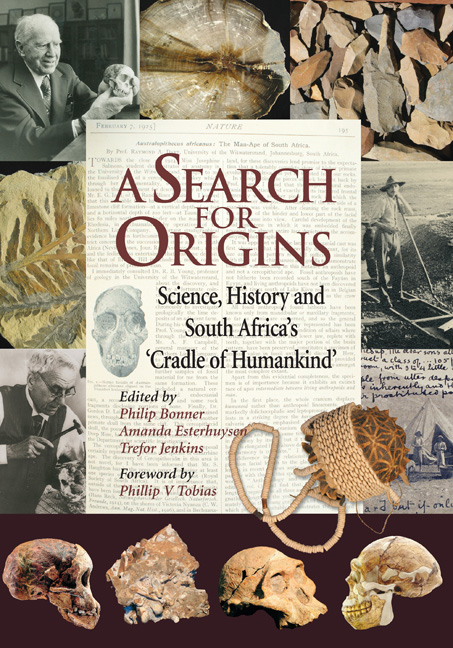Book contents
- Frontmatter
- Contents
- Map
- Foreword
- PART 1 Introduction: Africa is Seldom What It Seems
- PART 2 Introduction: Fossils and Genes: A New Anthropology of Evolution
- Chapter 2 A History of South African Palaeoanthropology
- Chapter 3 Fossil Hominids of the ‘Cradle of Humankind’
- Chapter 4 Unravelling the History of Modern Humans in Southern Africa: The Contribution of Genetic Studies
- Chapter 5 Fossil Plants from the ‘Cradle of Humankind’
- PART 3 Introduction: The Emerging Stone Age
- PART 4 Introduction: The Myth of the Vacant Land
- PART 5 Introduction: The Racial Paradox: Sterkfontein, Smuts and Segregation
- Epilogue: Voice of Politics, Voice of Science: Politics and Science After 1945
- Notes, references and recommended reading
- Notes on contributors
- Acknowledgements
- Index
Chapter 5 - Fossil Plants from the ‘Cradle of Humankind’
from PART 2 - Introduction: Fossils and Genes: A New Anthropology of Evolution
Published online by Cambridge University Press: 31 May 2019
- Frontmatter
- Contents
- Map
- Foreword
- PART 1 Introduction: Africa is Seldom What It Seems
- PART 2 Introduction: Fossils and Genes: A New Anthropology of Evolution
- Chapter 2 A History of South African Palaeoanthropology
- Chapter 3 Fossil Hominids of the ‘Cradle of Humankind’
- Chapter 4 Unravelling the History of Modern Humans in Southern Africa: The Contribution of Genetic Studies
- Chapter 5 Fossil Plants from the ‘Cradle of Humankind’
- PART 3 Introduction: The Emerging Stone Age
- PART 4 Introduction: The Myth of the Vacant Land
- PART 5 Introduction: The Racial Paradox: Sterkfontein, Smuts and Segregation
- Epilogue: Voice of Politics, Voice of Science: Politics and Science After 1945
- Notes, references and recommended reading
- Notes on contributors
- Acknowledgements
- Index
Summary
The fossil hominids and fauna from the ‘Cradle of Humankind’ are well known, but it is also important to know the plant environment in which they lived, died and evolved. We can obtain an indication of the environmental conditions by comparing fossil fauna with closely related modern animals whose climate and vegetation preferences we know. Then we assume that the fossil relative lived under the same conditions. Problems arise when the fossil evidence includes a mixed assemblage of animals from different environments or from different times. In addition, the correct identification of the fossil animal is most important.
On many sites we have to rely only on faunal and sedimentological clues to the past vegetation and climate, because no plants have been preserved. Fortunately some sites contain fossil plant material from some of the time intervals. As research continues on these sites, more plant material will probably be recovered. The sites where plant fossils have been found are described below, together with an assessment of these fossils’ reliability for palaeoclimate reconstructions.
The taphonomy of plants
Throughout geological time fossils are abundant in some areas, but for the most part the rocks contain either trace fossils (footprints, trackways, tunnels), invertebrate fossils (shells, for example), vertebrates (bones but no soft tissue) or plants. Seldom do two or more of these groups occur together. Yet in life, they most certainly occurred together. The study of the process of transition from a life assemblage to a death assemblage and what happens thereafter is called taphonomy (Efremov 1940; Martín-Closas & Gomez 2004). Clearly, a study of plant fossils is an important aspect of any efforts to reconstruct these processes.
The first observation to be made is that plants occur virtually everywhere on the surface of the earth and in many parts of the sea. Even when plants are alive, leaves fall off (seasonally or less frequently); flowers, fruits and cones fall off; and pollens or spores are dispersed by wind or insects. When the plant dies it usually breaks up even more, separating into leaves, twigs, seeds, flowers, trunk and roots. The different parts of any one plant vary in weight, size, shape and hardness and so are dispersed farther from or closer to the living plant. For example, the trunk and roots of a tree may not move at all.
- Type
- Chapter
- Information
- A Search for OriginsScience, History and South Africa's ‘Cradle of Humankind’, pp. 91 - 102Publisher: Wits University PressPrint publication year: 2007



